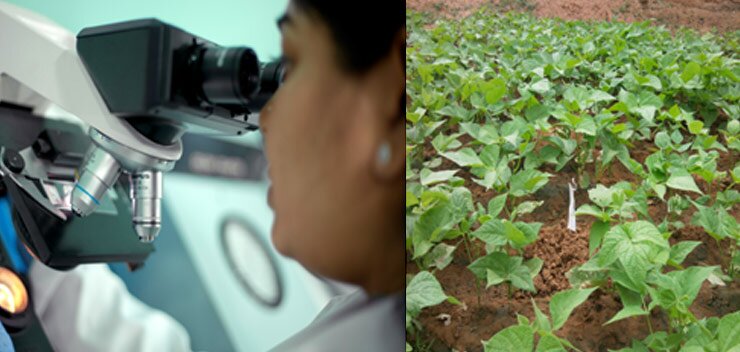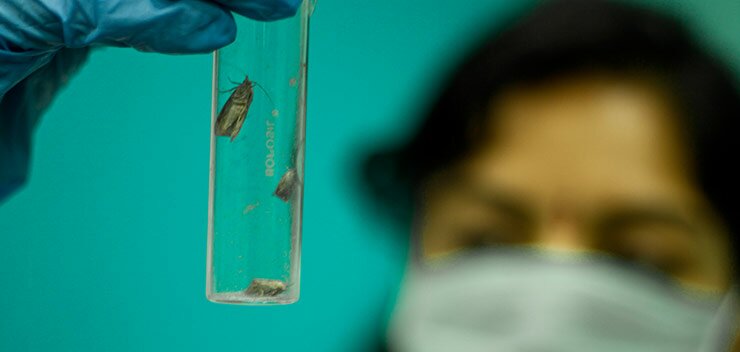Biological Control of Agriculturally Important Pests Using Beneficial Nematodes and Their Symbionts
Cabbage, Brassica oleracea var. capitata L. and cauliflower, B. oleracea var. botrytis L. are important crucifers grown in India in areas of 2,32,800 and 2,78,800 hectares, respectively. The diamondback moth (DBM), Plutella xylostella (Linnaeus) (Plutellidae: Lepidoptera), is the major pest on cruciferous crops causing significant economic losses (92% farmers) of upto 50% with an estimate of US$ 168 million per year.
DBM infestation was reported in India during 1914 on cruciferous vegetables and is now the most noxious pest of cole crops in the states of Punjab, Haryana, Himachal Pradesh, Delhi, Uttar Pradesh, Bihar, Maharashtra, Tamil Nadu and Karnataka. Duration of their life cycle is very short which enhances population range in the field conditions. They undergo more than 15 generations a year in the tropics. For immediate results, farmers rely on increased doses of insecticides, when insecticides alone account for 30-40% of the total production cost. Sole reliance on insecticides has resulted in rapid build-up of resistance in DBM. Health problems of farmers are common in the states where these crops are grown. DBM has shown high frequency of resistance in fenvalerate, monocrotophos, quinalphos, carbosulfan, spinosad and emamectin. Resistances are shown even to the Bacillus thuringiensis endotoxins.
Potential of Nematodes in Biological Control of Insects
Experts, when using exotic species that can cause reduction of endemic species population have rated high risk of biological pollution. Conservation strategies are also poorly developed since little is known about their field ecology, with dramatic variation in Entomopathogenic nematodes (EPNs) densities in response to temperature and moisture extremes. Attempts to manipulate ecological constraints to maintain nematode populations must be taken into consideration.
Augmentative releases of EPNs have been used to enhance biological control of pests in agro ecosystems. Currently they are used inundatively as a pesticide. Nematodes act as predator, pathogen and parasitoid, wherein they go in search of prey associating with bacterial pathogen, feed on it and finally kill the prey. Therefore, EPN belonging to genera Steinernema and Heterorhabditis are most focused for their implementation as biocontrol agents, as a part of IPM.
Advantages of Entomopathogenic nematodes
- Wide host range
- Non-specific development
- Show qualities of parasitoid, pathogen and predator
- Kill the host within 24-48 hours
- Can be mass-produced in artificial media
- Can stay viable for months
- Compatible with insecticides, herbicides and fertilizers
- No evidence of natural or acquired resistance to bacteria
- Safe to non-target organisms and eco-friendly
- Exempted from Pesticide Registration from the US Environmental Protection Agency (EPA)
Our Area of Focus-EPNs
To achieve sustainable management of natural resources and augment the effectiveness of arthropod pest control, biocontrol agents such as EPNs are being considered as an alternative to chemical pesticides. At Genelon, we target some of the most damaging insect species belonging to Lepidoptera, the second largest insect order comprised of moths and butterflies. In view of their voracious appetites, they can be quite destructive to many commercial crops. We focus on developing strategies to effectively manage a noxious cosmopolitan lepidopteron pest of crucifers (crops of the cabbage family), the diamondback moth (DBM), Plutella xylostella. DBM is touted to be the first insect pest resistant to all major synthetic insecticides and even to the Bacillus thuringiensis toxins causing huge economic losses.
Our aim is to evaluate potential EPNs against the larvae of DBM, with maximum efficacy in terms of infectivity and to standardize the production technology, strategize the suitable formulation and application technologies that would render a cost cutting product with enhanced pest control traits. This model would be validated for its efficacy against the target pests through extensive field trials.
Our Collaborators
- University of Agriculture Sciences, Bangalore
- University of Agriculture Sciences, Raichur







